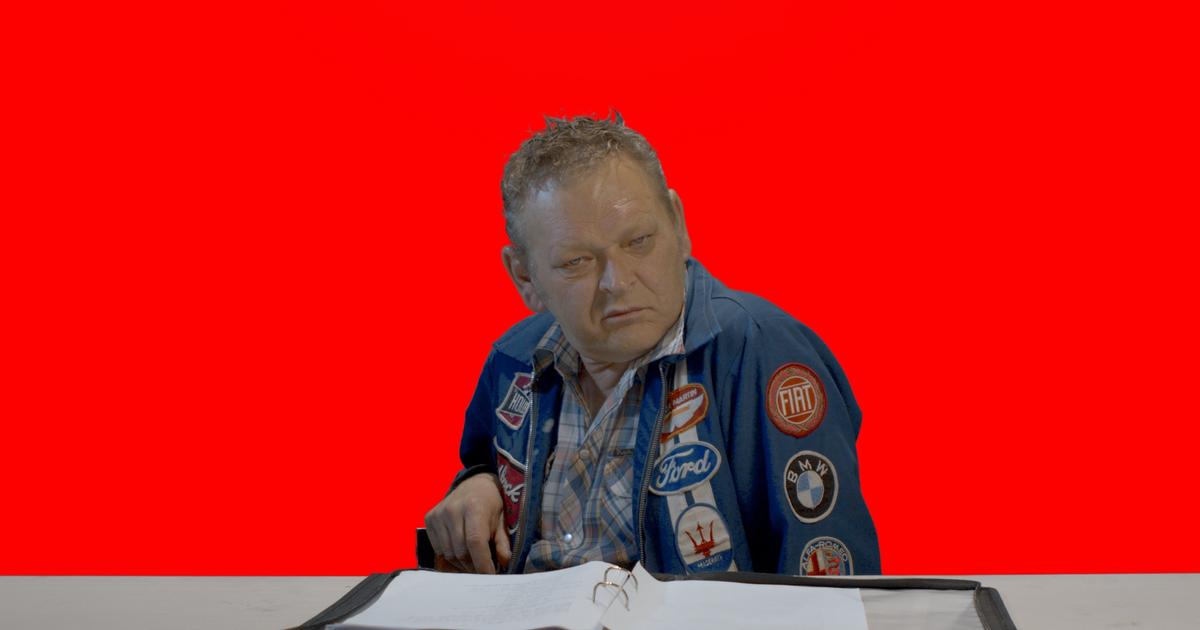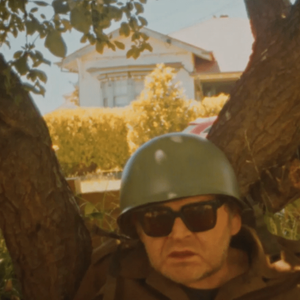The doppelgänger is simultaneously subject and object; it is an enactment of the mirror stage of subject formation on one hand, and on the other hand it is the embodiment of the return of the repressed, the materialization of the constitutive excess of modern subjectivity.
Drawing attention to the psychology of the doppelgänger seems fitting because Ronnie van Hout creates artworks to subtly question identities or move among multiple ones. He is best known for creating sculptural duplicates of himself often presented in tableau vivant to be encountered by an audience. Self-portraits in a series of transitional states, in the physical, social, and psychological sense. Like Dostoevsky’s Stavrogin reflecting on his own doppelgänger: "It shows different faces and assumes different characters, and yet is always the same."(1) He has placed his likenesses in front yards, stages, movie sets, flimsy passages and waiting rooms. Such inbetween spaces confuse orientation, they complicate oppositions and make location less straightforward. Indeed, for the past twenty five years van Hout’s "doubles" have deliberately blurred the boundaries between self and other, artist and audience, bringing attention to the fluidity of such oppositional terms as original and imitation, or difference and repetition. More specifically, in van Hout’s recent exhibition Ghosting at Ivan Anthony, the artist inhabits multiple, non-concordant identities at once. Tensions between group identities and individual voices are teased out by van Hout in this latest exhibition.
Each of the works manifest the artist’s exploration of transitional identity, a subject position unfolding towards new ways of life. According to theorist Herbert Harris, maintaining the integrity of one’s identity is an "ongoing struggle through adulthood," it involves the role played by “language” as a vehicle of self-definition, and affinity to a particular group that are both "complex" and "obscure."(2) French thinkers Gilles Deleuze and Félix Guattari offer a model of subjectivity in which the subject is a consequence of ‘becomings’, specifically those becomings of differentiation underlying the appearance of individuality. A line of becoming, Deleuze and Guattari write:
"...is not defined by points that it connects, or by points that comprise it; on the contrary, it passes between points, it comes up through the middle, it runs perpendicular to the points first perceived, transversely to the localizable relation to distant and continuous points."(3)
As an effect of becoming, Deleuze and Guattari’s subject can never be a completed project, because its temporality (time as continuous variation) determines that it is perpetually engaged in the process of becoming different. Correspondingly, integral to van Hout’s presentation as a whole is the population of individuals swept up in transitional processes—whether they be psychic, bodily, social or institutional—with particular reference to transitive locations.
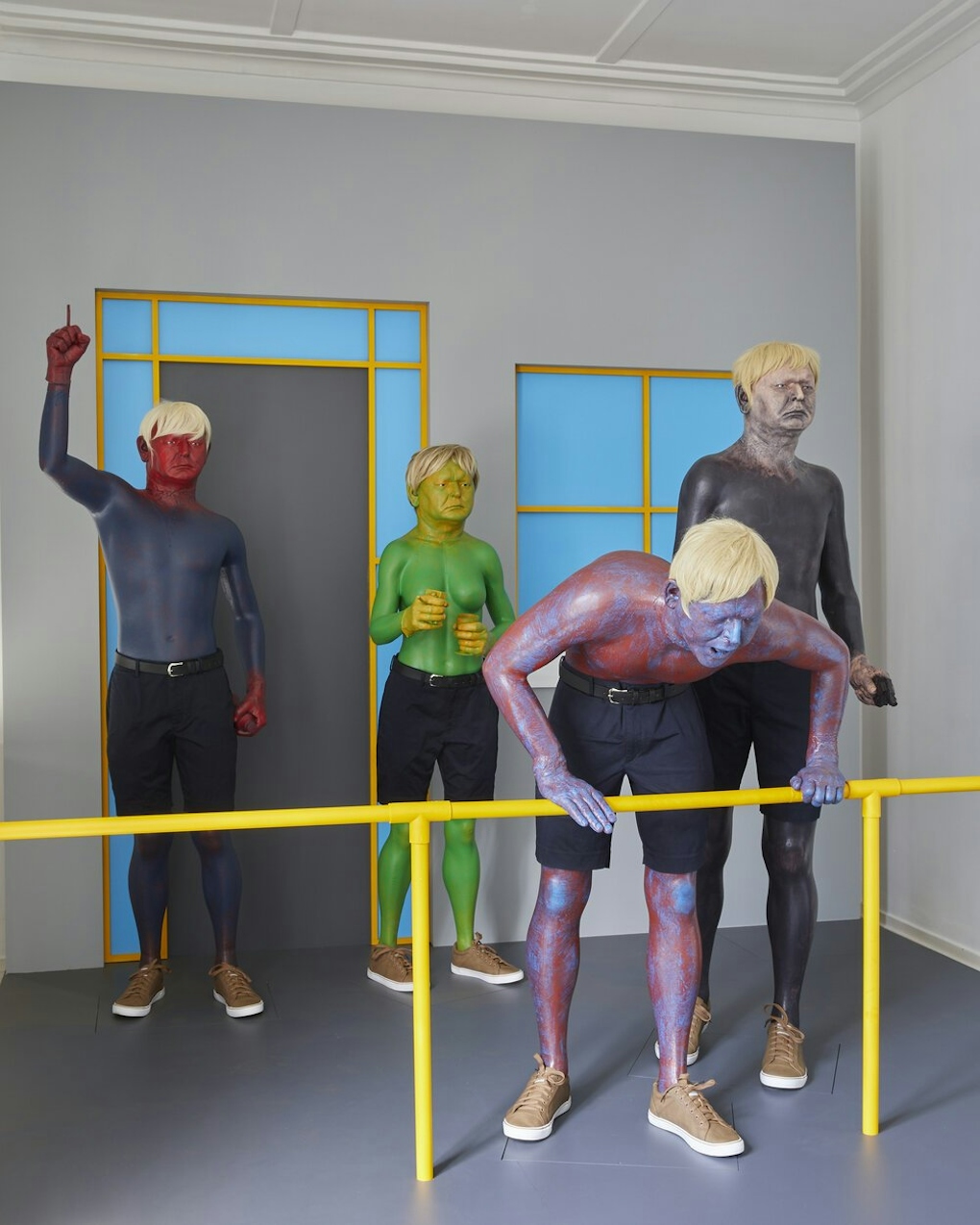
Installation view of Ghosting (2020) Ronnie van Hout. Painted MDF and pvc pipe, painted cast rigid urethane resin, expanded urethane foam, CNC expanded polystyrene, urethane spray, clothing, wigs, glass eyes, 3000 x 3000 x 3000mm. Photo by Sam Hartnett. Courtesy of Ivan Anthony
On entering the first room of Ivan Anthony, I encounter Ghosting (2020) as a contested space, a stand-off between artwork and viewer, yet also an invitation for response and a call for reflection upon all sorts of issues. Poised there are four life-sized Ronnie doppelgängers: figures that seem to threaten, to provoke, and to conceal within themselves their own enigmatic meanings. They stand in an interstice, fenced off between home and the outside world, in a front yard. Confined, they invite you to figure out their relationship, sense their collective intention.
At the rear is what seems like a simple house façade, modestly painted in blue and grey, with yellow window trimmings. Step closer and you come to a stop. The space between the house and its thigh-high, yellow fence is a kind of enclosure, a space free of authoritarian order. This might be a testing ground for its protagonists, or perhaps a waystation demarcated for emerging adulthood. The figures are clothed in shorts and polychrome skin, as if extra-terrestrial. One, a distressed, blue and red coloured man, hunches as if vomiting. Another, a red-faced man, brandishes a cigarette in a raised fist. Another figure, a short woman, with green body, stands aloof with a wine glass in one hand as if assessing possibilities or a threat. She wears a coarse blonde wig, is stood at the rear and stares into the distance. This is in contrast to the most threatening character here, ashen faced and grey bodied, blankly holding a pistol. Ghosting is based on an online photograph of university students in party mode, with changes made to their accoutrement. Yet it is also an example of self-portraiture in the extreme—four Ronnie doppelgängers put on display, a repetition of self-exposure.
Yet the more I pondered the work, the less certain I felt about the meaning of this exposure. After all, whatever van Hout’s doubles are thinking or feeling in this tableau is hidden behind those inscrutable stares. And the sense of concealment is heightened by his role-playing, that practice which depends upon artifice and contrivance. All this is compounded by an exhibition that explores such confusions of acting and living. And finally there is the work’s title, which is not "Here I Am" but rather Ghosting—a title which conjures up the trace, a space in between presence and absence. The word ‘ghosting’ conveys two meanings: first, a fuzzed, remnant video image, second, to end a relationship without explanation. Given these clues, van Hout turns the self-portrait on its head. Rather than any self-reveal, the tableau strikes me now as an assertion of self-othering and the elusiveness of self.
Whatever van Hout’s doubles are thinking or feeling in this tableau is hidden behind those inscrutable stares. And the sense of concealment is heightened by his role-playing, that practice which depends upon artifice and contrivance.
In an adjacent room, Ghosting (The Garden) consists of a single channel video transferred from a Super 8 film. Presented vertically on a flat screen television mounted to the ceiling, the duration of the piece is 12 minutes and 50 seconds. The film is a rumination upon identity and place filmed within the artist’s front yard in Melbourne. In the first colour section, van Hout plays a US soldier in a war film and recites from The Other Face to be (1913), a rhetorical poem by De Stijl founder, Theo van Doesburg, pseudonym of Christian Emil Marie Küpper (1883-1933). Familiar with invented second selves, van Doesburg used the pen names I. K. Bonset for his Dada writings and Aldo Camini for a philosophic text, Het andere gezichi (The Other Face). In The Other Face to be, van Doesburg explores the tension between individual and collective processes of identity formation. His text resonates with the modern idea of progress through the emancipation of individuals from prescribed identities. Existing in an in-between of identity, van Hout’s voice assumes a performative character, redolent of historic layers of theatrical articulation. At the most immediate level, the soldier’s voice echoes a rather ancient one: he acts, precisely, in the manner of Shakespeare’s Hamlet. As is the case in this well-known literary character, he articulates a fragmented, autonomous self that has both the power of interior reflection and expression and also a sense of depth. According to literature theorist Katharine Maus, subjectivity "is often treated casually as a unified or coherent concept when, in fact, it is a loose and varied collection of assumptions, intuitions, and practices that do not all logically entail one another and need not appear together at the same cultural moment".(4) In this sense, van Hout’s disparate reference points suggest the negotiation of identity through the overlapping experience of multiple identities and roles.
Ronnie van Hout, Ghosting (The Garden) 2020 (excerpts). Single channel video (colour/sound), 12:50:00mins, Super 8 film scanned to 4k digital, edition of 3 + 1 AP. Text by Theo van Doesburg, The Other Face to be, De Stijl magazine, Vol XIII (1926), pg 64. Music by Echo and the Bunnymen, Villiers Terrace from the album Crocodiles (1980). Improv guitar and string playing by Vito van Hout (2019). Courtesy of the artist
These existential and storied elements are paired with more non-narrative imagery. In the following scenes of Ghosting (The Garden), van Hout depicts fragments of the front yard, as features of an intensive materiality extrapolating itself through formal transformation. As imaged by the artist, a brick column circular newspaper slot becomes a camera lens — registering flickering light caused by passing motor vehicles. Since the black-and-white shot includes both sharpness and blur, an interplay occurs between representation and abstraction. Here, the artist touches on experimental cinema’s fabrication of new optical realities. In this sense, the newspaper slot becomes a symbolic portal to other extra-terrestrial worlds. This scene is accompanied by a soundscape by experimental guitarist Vito van Hout; it is dark and spacious, laced with feedback, reverberation and sudden blasts of dissonance. Switching to colour in the next shot, van Hout develops an approach more tactile than visual, a physical and sensory engagement with lawn grass that heightens our awareness of touch. We see the artist’s fingers caress a patch of dry, long grass. The interplay between the movement of hand and grass, light and shadow, shifts continuously. In a break with narrative, the artist hints at film’s tactile qualities and its ability to call forth viewers’ own embodiment as a condition for understanding. In the next scene, van Hout appears again, this time in a full shot, strutting and twirling a hose in front of his house. His jerky, awkward performance suggests a very different kind of rock star cool. The song Villiers Terrace (1980) by Echo and the Bunnymen accompanies him. In the final section, the artist continues to demonstrate a sensitivity to the textures of the material world. A series of close-ups scrutinise the materialities of the front yard and beyond. A parked car moves in and out of focus. Upon the surface of the mailbox, an ant scurries back and forth. In shifting between narrative and non-narrative, the artist counterpoints chronological, causal time (embodied in his on-screen performances) with heterogeneous, circular time (fusions of inorganic and organic realities).
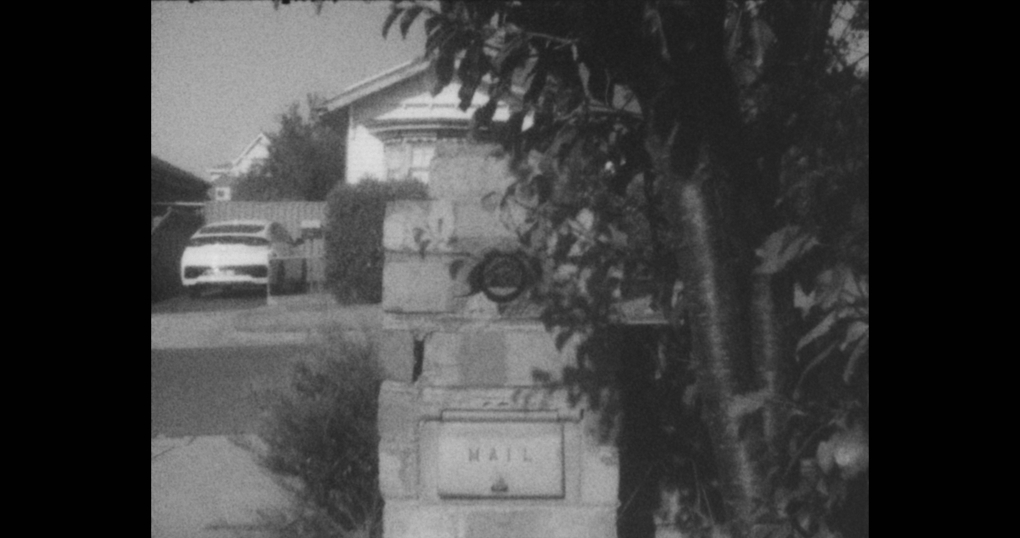
Still from Ghosting (The Garden) (2020) Ronnie van Hout. Single channel video (colour/sound), 12:50:00mins, Super 8 film scanned to 4k digital, edition of 3 + 1 AP. Text by Theo van Doesburg, The Other Face to be, De Stijl magazine, Vol XIII (1926), pg 64. Music by Echo and the Bunnymen, Villiers Terrace from the album Crocodiles (1980). Improv guitar and string playing by Vito van Hout (2019). Courtesy of the artist
Another film, Ghosting (The Breakfast Club) is van Hout’s homage to John Hughes’ film The Breakfast Club (1985), in which he performs the roles of students in a detention session—five individuals delivering lines from the film script. Here, the artist tries on the kinds of voices and roles that would usually belong to teenagers. As with the previously discussed works, van Hout emphasises the transversal movements of identity by suppressing—but not entirely erasing—narrative content and individual specificity (gender, culture, age cohort and family history). It is adolescents, of course, who find themselves in a liminal phase—often moving between adult-like and child-like responses to their transitional status. Importantly, van Hout’s on-screen recitation is not expressionless. Despite favouring ambiguity, he brings the script to life through costume, voice, and gestures.
The Breakfast Club assembles five student archetypes common to the teen film genre—the popular girl, Claire (Molly Ringwald); the jock, Andrew (Emilio Estevez); the rebel, John (Judd Nelson); the odd recluse, Allison (Ally Sheedy); and the nerd, Brian (Anthony Michael Hall)—and shows them sharing their experiences and forming unlikely friendships. Although for the most part van Hout recites Hughes’ script faithfully, both the setting and film technique are substantially altered. In place of a library interior and a cast of actors, van Hout speaks directly to camera with character-specific, block colour backdrops. While he evokes and disrupts The Breakfast Club, any reception of Ghosting (The Breakfast Club) depends upon the viewer’s knowledge (or lack thereof) of the film. Without prior knowledge of Hughes’ film, van Hout’s performance hinders any straightforward understanding of the script, a criss-crossing of different voices cut together and presented.
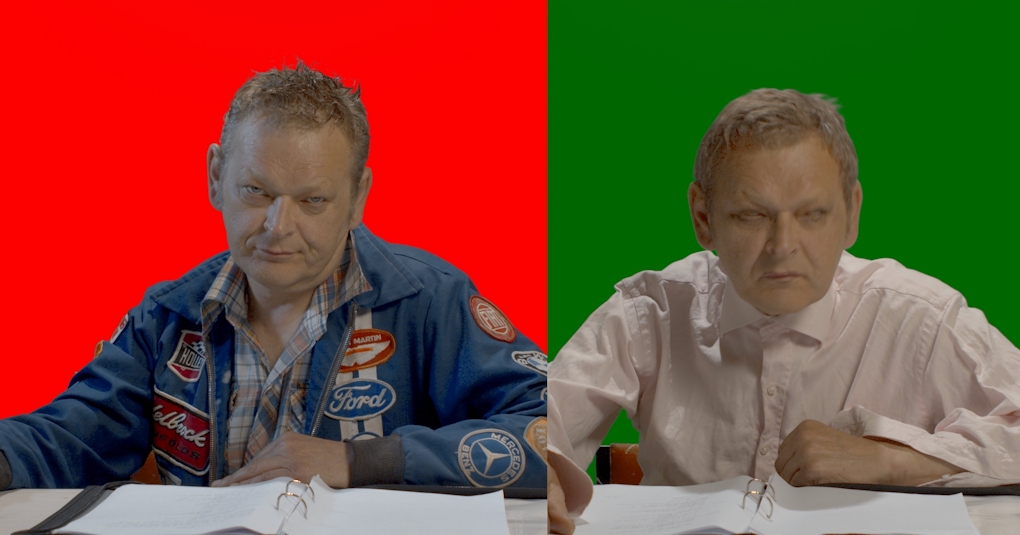
Still from Ghosting (The Garden) (2020) Ronnie van Hout. Single channel video (colour/sound), 12:50:00mins, Super 8 film scanned to 4k digital, edition of 3 + 1 AP. Text by Theo van Doesburg, The Other Face to be, De Stijl magazine, Vol XIII (1926), pg 64. Music by Echo and the Bunnymen, Villiers Terrace from the album Crocodiles (1980). Improv guitar and string playing by Vito van Hout (2019). Courtesy of the artist
The three works in the exhibition all in some way explore the nature of identity production through various sociocultural mechanisms. From this perspective, the concept of identity is produced continually in individuals and by their interactions with others and social practices. Through the different personas that he adopts, van Hout critically questions the concept of "self" as a unified, identifiable presence or entity. His radical self-referential doubling and self-dispersal suggests the heterogeneity of identity through a play of differences. In this sense, he moves beyond the decentred self to suggest that the self is actually a plural phenomenon which uses multiple discourses or "voices" to constitute meaning. In Ghosting (The Breakfast Club), instead of presenting five characters through the traditional deployment of five individual actors, van Hout suggests five "selves." Lacking their centre, his selves disperse, multiply and disarticulate themselves until their intent erodes into surface, flatness and blankness.
